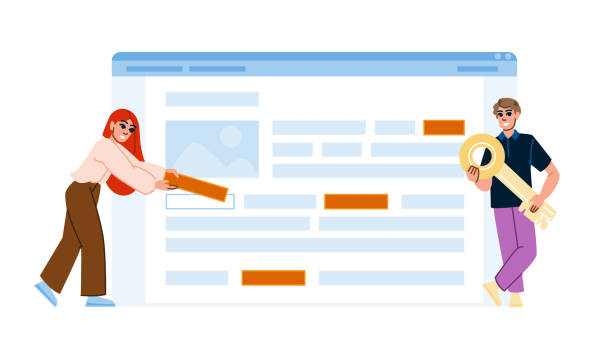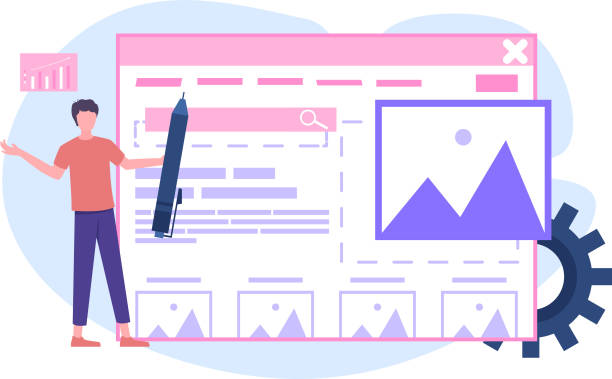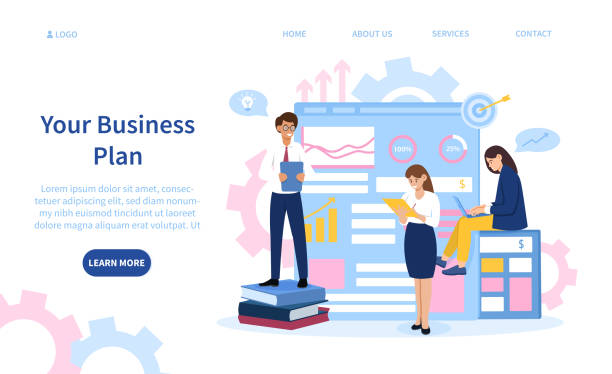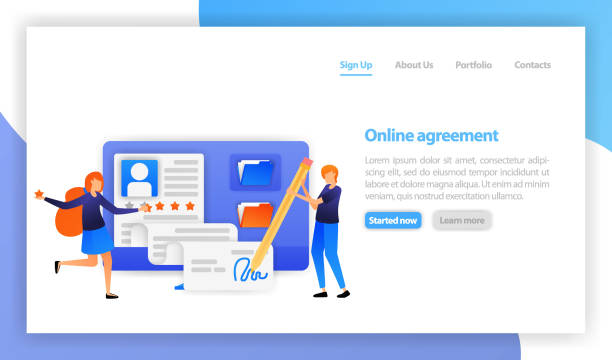Introduction to the Importance of Multilingual Website Design

In today’s world, where geographical boundaries are rapidly blurring, a global online presence is no longer a privilege, but an unavoidable necessity. For businesses looking to expand their global market and connect with #more_audiences, multilingual website design acts as a strategic backbone.
This approach allows you to deliver your message not only in the native language of potential customers but also to align with their culture and traditions.
A single-language website covers only a small portion of the global market, while multilingual website design opens doors to billions of new users.
This leads to #increased_sales directly through access to new markets and also improved global SEO.
Search engines index multilingual websites better, which means more visibility and higher traffic.
Furthermore, enhancing the user experience (UX) by providing content in the user’s preferred language significantly increases their trust and loyalty.
This approach is not limited to text translation; it includes full localization, such as adjusting date and time formats, currencies, and even images and video content for different target markets.
Multilingual website design is a smart investment that yields significant long-term returns for any business, from the smallest startups to the largest multinational corporations.
Did you know that 94% of users’ first impressions of a business are related to its website design? With professional corporate website design by **Rasweb**, turn this first impression into an opportunity for growth.
✅ Attract more customers and increase sales
✅ Build credibility and trust in the audience’s view⚡ Get a free website design consultation!
Challenges Ahead in Implementing Multilingual Website Design

Despite its numerous benefits, implementing and multilingual website design can come with complex challenges that require meticulous planning and sufficient expertise.
One of the first and largest challenges is content translation and localization management.
This is not merely limited to word-for-word translation; the website’s tone, style, and core message must be preserved and align with the culture of the new audiences.
Using machine translations without human review can lead to glaring errors and damage brand reputation.
Another challenge is choosing the appropriate technical infrastructure; should one use subdomains, subdirectories, or country-code top-level domains (ccTLDs)? Each option has its own advantages and disadvantages in terms of SEO, management, and costs.
Technical management, such as implementing hreflang tags to guide search engines about different language versions, is of high importance.
Ignoring these aspects can lead to weakened SEO and search engine confusion.
Additionally, optimizing the user experience (UX) for each language and culture, including text direction (such as right-to-left in Persian and Arabic), fonts, images, and even colors, is another challenge that should not be overlooked.
Ensuring the compatibility of the content management system (CMS) with multiple languages, as well as maintaining website loading speed across different versions, are other technical obstacles.
Finally, continuous updating and maintenance of content in all languages is a long-term commitment that requires ongoing resources and planning.
Addressing these challenges with a comprehensive and specialized approach is key to success in any multilingual website design project.
Choosing the Right Strategy for Multilingual Website Design

Choosing the right strategy for multilingual website design is one of the key decisions that profoundly impacts your website’s SEO, management, and overall success.
There are three main strategies for structuring multilingual websites: using country-code top-level domains (ccTLDs), subdomains, and subdirectories.
Each of these options has its own advantages and disadvantages that should be evaluated based on business goals, budget, and available resources.
ccTLDs, such as .fr for France or .de for Germany, give the strongest geographical signal to search engines and can be useful for very specific and distinct markets.
However, managing multiple domains and their costs can be challenging.
Subdomains, such as fr.example.com or de.example.com, are considered separate entities by SEO, each requiring its own domain authority and separate optimization, but technically they are easier to manage than ccTLDs.
This option is suitable for large organizations or those who want to keep their different language versions SEO-independent.
Subdirectories, such as example.com/fr/ or example.com/de/, are the most common and often recommended approach.
This structure is easy to implement and manage, and it transfers the main domain’s authority to different language versions, which benefits the site’s overall SEO.
Google also generally prefers subdirectories over subdomains, as it sees them as part of a single main domain.
The choice of strategy should be made considering long-term SEO goals, ease of content management, and your budget.
Consulting with specialists in multilingual website design and international SEO is essential for making an informed decision.
| Strategy | Advantages | Disadvantages | Suitable For |
|---|---|---|---|
| ccTLDs (Country Code Top-Level Domains) | Strongest geographical signal, high local trust | High cost and management, need to build separate SEO authority | Highly distinct and large markets, multinational companies |
| Subdomains | Technical flexibility, content separation | Need to build separate SEO authority (like ccTLDs), complexity in some webmaster tools | Medium to large businesses, projects with moderate budgets |
| Subdirectories | Stronger SEO due to main domain authority transfer, easier management | Weaker geographical signal (requires hreflang), risk of issues if main domain errors occur | Most businesses, especially for starting multilingual implementation |
Technical Aspects and SEO Optimization in Multilingual Website Design

The success of a multilingual site depends more than anything on the precise adherence to its technical aspects and SEO optimization.
One of the most important technical elements is the correct implementation of hreflang tags.
These tags help search engines like Google identify different language versions of a page and ensure that users see the appropriate language and region version.
Without these tags, search engines might consider similar content as duplicate content, which harms the site’s SEO.
In addition to hreflang, using Canonical tags for each language version is also important to prevent search engine confusion.
The URL structure must be logical and clear and indicate the content language (as mentioned in the previous section regarding subdomains and subdirectories).
Site loading speed is also a crucial factor in SEO; each language version should load quickly, even if its content is more voluminous.
This includes optimizing images, compressing code, and using a CDN (Content Delivery Network).
Also, keyword research for each language separately, considering cultural and dialectical differences, is essential.
A keyword effective in one language might not yield results or might have a different meaning in another.
Finally, continuous monitoring of SEO performance in tools like Google Search Console for each language version allows you to identify and resolve potential issues and ensure that your multilingual website design ranks well in search engines.
Are you losing potential customers due to an unprofessional website? Rasweb is your answer! With our specialized corporate website design services:
✅ Enhance your business’s credibility and standing
✅ Experience attracting more targeted customers
⚡ Act now to get a free consultation!
Content and Translation Management in Multilingual Sites

Content management and the translation process are the core and one of the most complex aspects of multilingual website design.
Translation quality not only affects user experience but also impacts brand reputation and SEO rankings. Using native and specialized translators in each field is crucial; machine translation, while faster, usually lacks accuracy, cultural nuances, and appropriate tone.
For large volumes of content, using Content Management Systems (CMS) with advanced multilingual capabilities, such as WordPress with WPML or Polylang plugins, Drupal, or Joomla, can significantly simplify the process.
These systems enable content management in various languages within a single panel.
Localization goes beyond mere translation; it involves adjusting all website elements for the specific target market.
For example, currencies, date and time formats, phone numbers, addresses, and even visual and video content must be aligned with the local culture.
An image that has a positive meaning in one culture might be offensive in another.
Creating a specialized Glossary and Style Guide for translators helps maintain consistency and quality in the long run.
Additionally, planning for regular content updates in all languages is essential to prevent outdated or contradictory content.
Content management on a multilingual website is an ongoing process that requires coordination between content, translation, and technical teams to ensure all language versions are always up-to-date and accurate.
User Experience (UX) in Multilingual Website Design

User Experience (UX) is one of the most important factors in the success of any website, and in the case of multilingual website design, its importance is twofold.
An inappropriate UX can lead to user confusion, frustration, and ultimately, site abandonment, even if the content is excellent.
The first step is to provide a clear and accessible way to change the language. This is usually done via a button or dropdown menu in the header or footer of the site, marked with country flags or language codes (such as EN, FR, FA).
The importance of automatic language detection based on the user’s browser or IP address, along with the option for manual change, should not be overlooked so that users can quickly access their desired content.
Visual and functional consistency across all language versions is also crucial.
Users should encounter the same user interface regardless of the language they choose.
This includes the placement of navigation elements, button styles, and the overall layout of pages.
Furthermore, observing cultural differences in visual and written design is also essential.
For example, text direction (right-to-left for languages like Persian and Arabic), fonts, color choices, and images must align with the tastes and cultural sensitivities of each geographical region.
Forms, dates, and currency units must be localized to be understandable and usable for local users.
Finally, conducting user tests with native speakers of each language is the best way to identify weaknesses and ensure a smooth and pleasant user experience in your multilingual website design.
Can users easily find their desired language? Do the forms work correctly? Is the content displayed properly? These are questions that can be answered through user testing.
Essential Tools for Multilingual Website Design and Maintenance

For successful multilingual website design and efficient maintenance, using the right tools and platforms is crucial.
These tools can significantly facilitate the translation process, content management, and even SEO optimization.
At the heart of every multilingual website is a powerful Content Management System (CMS) that supports localization capabilities.
Platforms like WPML and Polylang for WordPress, or localization modules in Drupal and Joomla, allow you to create and manage content in different languages.
For the translation process, Translation Management Systems (TMS) tools such as memoQ or SDL Trados Studio help translators work more efficiently and use Translation Memories and glossaries to maintain consistency and quality.
International SEO tools like Ahrefs, Semrush, and Screaming Frog are essential for keyword research, competitor analysis, and checking hreflang tags and localization issues.
Google Search Console is also a vital tool for monitoring website performance in various search engines and discovering localization-related errors.
Additionally, using a CDN (Content Delivery Network) is very important for improving website loading speed for users worldwide.
User Experience (UX) testing tools and analytics tools like Google Analytics are also essential for understanding user behavior in each language version and continuously optimizing the user interface and content.
All these tools combined provide a powerful ecosystem for successful multilingual website design implementation.
| Tool Category | Tool/Platform Example | Main Use |
|---|---|---|
| CMS with Multilingual Capability | WordPress (WPML/Polylang), Drupal, Joomla | Easy content and page management in different languages |
| Translation Management Systems (TMS) Tools | memoQ, SDL Trados Studio, Smartcat | Organize translation process, maintain consistency and quality of translation |
| International SEO Tools | Ahrefs, Semrush, Screaming Frog | Keyword research, competitor analysis, hreflang tag checking |
| Content Delivery Network (CDN) | Cloudflare, Akamai, Amazon CloudFront | Increase site loading speed for global users |
| Analytics and Reporting Tools | Google Analytics, Google Search Console | Monitor site performance, identify SEO and UX issues |
Case Study of Multilingual Website Design Successes

Significant successes in multilingual website design by leading global companies testify to the importance and high potential of this approach.
Airbnb, the giant of the digital hospitality industry, is a prime example of a fully localized website. This company has not only translated its content into dozens of languages but has also designed the user experience in a way that is completely natural and native for users from different cultures, including payment methods, price display, and even communication between hosts and guests.
This approach has helped Airbnb rapidly penetrate new markets and become a global brand.
Nike has also been very successful in multilingual implementation for its online stores. Nike’s website provides localized products, marketing campaigns, and content for each geographical region that is adapted to the language and culture of that specific region.
This strategy has enabled Nike to build deeper connections with its customers worldwide and significantly increase its sales.
The United Nations website is also an example of complex and large-scale multilingual website design. This website provides official information and documents in its six official languages (English, Arabic, Chinese, French, Russian, Spanish) and plays a vital role in informing and providing access to information for global audiences.
These successful cases show that investing in localization and providing content in the user’s native language not only increases customer trust and satisfaction but also directly impacts business growth and development on a global scale.
The success stories of these companies are inspiring and highlight the vast potential for other businesses to reach international markets through multilingual website design.
Are you tired of your e-commerce site having visitors but no sales? Rasweb solves your main problem with professional e-commerce website design!
✅ Significant sales increase with targeted design
✅ Flawless user experience for your customers
⚡ Get a free consultation now!
Future Trends in Multilingual Website Design and Artificial Intelligence
![]()
The future of multilingual website design is strongly linked to advancements in Artificial Intelligence (AI). AI has the potential to transform how content is produced, translated, and managed.
Currently, AI-powered machine translation tools like Google Translate or DeepL have significantly improved, but they still cannot fully replace human translators, especially concerning cultural nuances and tone.
However, the new generation of AI tools can play a central role in accelerating the translation process, providing high-quality initial drafts, and assisting in content localization. These tools can learn industry-specific phrases and terminology and help maintain translation consistency over time.
Another important trend is personalizing content based on geographical location and user language preferences. AI can dynamically deliver more relevant and localized content by analyzing user data, which leads to improved user experience and increased conversion rates.
Multilingual voice search and conversational AI are also other areas that will shape the future of multilingual websites.
With the proliferation of voice-activated devices, websites must be able to respond to voice queries in various languages.
Finally, AI can assist in analyzing international data and identifying market trends in different regions, which allows businesses to plan their content and marketing strategies more intelligently and targeted.
These developments indicate that multilingual website design will transition from a static state to a dynamic and intelligent system in the near future.
Frequently Asked Questions and Concluding Tips on Multilingual Website Design

On the path to multilingual website design, many questions may arise.
Do we need to hire an in-house translation team, or can we use external services? The answer to this question depends on the volume and sensitivity of the content.
For specialized and brand-sensitive content, a combination of expert translators and localization by individuals familiar with the target market, is the best approach.
How can we ensure the quality of translations? Using translation memories, specialized glossaries, and human review by native editors, is key to maintaining quality.
Should we translate all website content? No, you can start by translating the most important pages and sections and gradually localize more content based on user needs and feedback.
Focusing on core and strategic content initially, allows you to enter the market more quickly.
Concluding tips for a successful multilingual website design: Firstly, have comprehensive planning. Before starting the project, define your goals, identify target markets, and determine your technical and content strategy.
Secondly, think beyond mere translation for localization. Culture, currency, date, images, and even colors must align with the target region.
Thirdly, consider international SEO from the outset. Hreflang tags and appropriate URL structure, are crucial for visibility in search engines.
Fourthly, continuously gather feedback and optimize. The digital world is dynamic and your website should adapt accordingly.
Fifth, conduct user tests with native speakers. This helps you identify and resolve potential issues before widespread release.
By adhering to these tips, your multilingual website will not only be a communication tool but also a powerful lever for your business’s global growth and development.
Frequently Asked Questions
| Question | Answer |
|---|---|
| What is multilingual website design? | It is the design of a website whose content is available to users in several different languages, allowing users to choose their desired language. |
| Why is a multilingual site important? | To reach international audiences, increase site traffic, improve user experience for non-Persian speaking visitors, and expand business into global markets. |
| What are the benefits of having a multilingual site? | Increased international SEO, attracting new customers from different countries, enhancing business credibility and professionalism, and reducing bounce rate by providing understandable content. |
| What are the methods for implementing a multilingual site? | Using subdirectories (e.g., example.com/en/), subdomains (e.g., en.example.com), or separate top-level domains for each language (e.g., example.com and example.de). |
| Which URL structure is best for international SEO? | Subdirectories (e.g., example.com/en/) are often preferred for SEO due to consolidating the main domain’s authority, although each method has its advantages and disadvantages. |
| How does a multilingual site affect SEO? | By providing content in different languages, the site appears in local search results for those languages, click-through rates and traffic increase, and the overall domain authority improves. Correct use of hreflang tags is crucial. |
| How is content translation managed? | You can use professional translators, machine translation tools (with human editing), or Content Management Systems (CMS) with built-in multilingual capabilities or relevant plugins. |
| What are the common challenges in multilingual website design? | Managing translated content, maintaining design consistency across different languages, compatibility with right-to-left (RTL) languages like Persian and Arabic, SEO optimization for each language, and choosing the appropriate URL structure. |
| How do I manage text direction (LTR/RTL) on a multilingual site? | For right-to-left languages (such as Persian), you need to apply specific CSS styles for changing text direction, element arrangement, and table direction. This is often done using the direction: rtl; property and other related settings. |
| How can users change the site language? | Usually by using a button, dropdown menu, or language selector widget clearly placed in the site’s header or footer. Automatic detection of the user’s browser language and offering a language change is also common. |
And other services of RasaWeb Advertising Agency in the field of advertising
Smart Google Ads: A professional solution for attracting customers with a focus on precise audience targeting.
Smart Advertorials: A professional solution for attracting customers with a focus on precise audience targeting.
Smart Content Strategy: A professional solution for campaign management focusing on marketing automation.
Smart UI/UX: A new service for increasing online growth through marketing automation.
Smart Digital Advertising: An innovative platform for improving user engagement through optimizing key pages.
And over a hundred other services in the field of internet advertising, advertising consultation, and organizational solutions
Internet Advertising | Advertising Strategy | Advertorials
Sources
Benefits of Multilingual Website DesignGuide to Global Business ExpansionSEO Optimization Tips for Multilingual WebsitesNew Horizons in International Trade
? Are you looking for significant growth for your business in the online space? “Rasweb Afarin” Digital Marketing Agency guides your brand towards success by providing innovative and comprehensive solutions including multilingual website design, SEO, and social media management. Contact us today and transform your digital future!
📍 Tehran, Mirdamad Street, next to Bank Markazi, Southern Kazeroon Alley, Ramin Alley, No. 6




